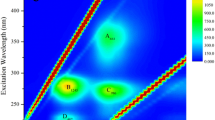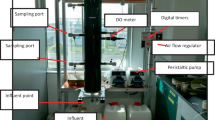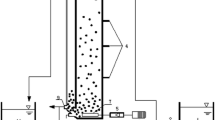Abstract
Aerobic granules can be used for the treatment of industrial or municipal wastewater, but high aeration rate is required for the stable operation of the granular sludge system. Therefore, the aim of this research was to reduce aeration rate greatly to decrease the energy consumption for the technology of aerobic granules. Based on the characteristics of sequencing batch reactor with distinct feast and famine periods, aeration rate was reduced from 1.66 to 0.55 cm s−1 in the famine period after granules were formed. It was found that the settleability of aerobic granules in reactor R1 with reduced aeration was the same as that of aerobic granules in reactor R2 with constant aeration rate of 1.66 cm s−1. However, the outer morphology of aerobic granules gradually changed from round shape to long shape, and minor population showed certain shift after aeration rate was reduced in the famine period. Since good settleability is the most essential feature of aerobic granules, it can be said that reducing aeration rate in famine period did not influence the stable operation of aerobic granular sludge system. Furthermore, the experimental results indicated that aeration rate in feast period was much more important to the stable operation of aerobic granules than that in famine period.




Similar content being viewed by others
References
APHA (1998) Standard methods for the examination of water and wastewater, 19th edn. American Public Health Association, Washington, DC
Arrojo B, Mosquera-Corral A, Garrido JM, Mendez R (2004) Aerobic granulation with industrial wastewater in sequencing batch reactors. Water Res 38:389–3399
Ben-Jacob E, Cohen I, Levine H (2000) Cooperative self-organization of microorganisms. Adv Phys 49:395–554
Beun JJ, van Loosdrecht MCM, Heijnen JJ (2002) Aerobic granulation in a sequencing batch airlift reactor. Water Res 36:702–712
Bossier P, Verstraete W (1996) Triggers for microbial aggregation in activated sludge? Appl Microbiol Biotechnol 45:1–6
Chen MJ, Zhang Z, Bott TR (1998) Direct measurement of the adhesive strength of biofilms in pipes by micromanipulation. Biotechnol Tech 12:875–880
Jiang HL, Tay JH, Maszenan AM, Tay STL (2004) Bacterial diversity and function of aerobic granules engineered in a sequencing batch reactor for phenol degradation. Appl Environ Microbiol 70:6767–6775
Lettinga G, van Velsen AFM, Hobma SM, de Zeeuw W, Klapwijk A (1980) Use of the upflow sludge blanket (USB) reactor concept for biological wastewater treatment especially for anaerobic treatment. Biotechnol Bioeng 22:699–734
Morgenroth E, Sherden T, van Loosdrecht MCM, Heijnen JJ, Wilderer PA (1997) Aerobic granular sludge in a sequencing batch reactor. Water Res 31:3191–3194
Muyzer G, de Waal EC, Uitterlinden AG (1993) Profiling of complex microbial populations by denaturing gradient gel electrophoresis analysis of polymerase chain reaction-amplified genes coding for 16S rRNA. Appl Environ Microbiol 59:695–700
Ohashi A, Harada H (1994) Adhesion strength of biofilm developed in an attached-growth reactor. Water Sci Technol 29(10–11):281–288
Pan S, Tay JH, He YX, Tay STL (2004) The effect of hydraulic retention time on the stability of aerobically grown microbial granules. Lett Appl Microbiol 38:158–163
Pratt LA, Kolter R, (1999) Genetic analysis of bacterial biofilm formation. Curr Opin Microbiol 2:598–603
Qin L, Liu Y, Tay JH (2004) Effect of settling time on aerobic granulation in sequencing batch reactor. Biochem Eng J 21:47–52
Tay JH, Liu QS, Liu Y (2001) The effects of shear force on the formation, structure and metabolism of aerobic granules. Appl Microbiol Biotechnol 57:227–233
Tay JH, Yang SF, Liu Y (2002a) Hydraulic selection pressure-induced nitrifying granulation sequencing batch reactors. Appl Microbiol Biotechnol 59:332–337
Tay STL, Ivanov V, Yi S, Zhuang WQ, Tay JH (2002b) Presence of anaerobic Bacteroides in aerobically grown microbial granules. Microb Ecol 44:278–285
Tay JH, Liu QS, Liu Y (2004) The effect of upflow air velocity on the structure of aerobic granules cultivated in a sequencing batch reactor. Water Sci Technol 49:35–40
Trinet F, Heim R, Amar D, Chang HT, Rittmann BE (1991) Study of biofilm and fluidization of bioparticles in a three-phase fluidized-bed reactor. Water Sci Technol 23:1347–1354
Villasenor JC, van Loosdrecht MCM, Picioreanu C, Heijnen JJ (2000) Influence of different substrates on the formation of biofilms in a biofilm airlift suspension reactor. Water Sci Technol 41:323–330
Yu HQ, Tay JH, Fang HHP (2001) The role of calcium in sludge granulation during UASB reactor start-up. Water Res 35:1052–1060
Acknowledgements
This work was supported by research funds from Nanyang Technological University to Professor Joo-Hwa Tay. Dr. Yong-Qiang Liu is supported by a Singapore Millennium Foundation (SMF) postdoctoral scholarship.
Author information
Authors and Affiliations
Corresponding author
Rights and permissions
About this article
Cite this article
Liu, YQ., Tay, JH. & Moy, B.YP. Characteristics of aerobic granular sludge in a sequencing batch reactor with variable aeration. Appl Microbiol Biotechnol 71, 761–766 (2006). https://doi.org/10.1007/s00253-005-0209-1
Received:
Revised:
Accepted:
Published:
Issue Date:
DOI: https://doi.org/10.1007/s00253-005-0209-1




